When you think of China and its mythology, one of the first creatures that spring to mind is the Chinese dragon. This legendary creature is, without a doubt, one of the most well-known aspects of Chinese culture abroad.
But what do you really know about the Chinese dragon? Aside from that, it’s a pretty cool Chinese Zodiac Sign and a popular choice for a tattoo? Do you know what a Chinese dragon means and symbolizes? No? Then you’ve come to the right place. I’m going to tell you the essential things to know about the Chinese dragon. You’ll learn what they look like, what link they have with human beings, cool Chinese dragon facts, their role in Chinese society, and more! Ready to learn everything you’ve ever wanted to know about the Chinese dragon, the coolest creature to not-roam the earth?
🏮 Ninchanese is an incredible app for learning Chinese! 🏮
” I actually graduated from the University of Edinburgh with a MA in Chinese.
I’ve used Ninchanese daily, and it has helped me a lot! “
– Connor, Ninchanese User
Try Ninchanese, an award-winning method to learn Chinese today:
Start Learning Now
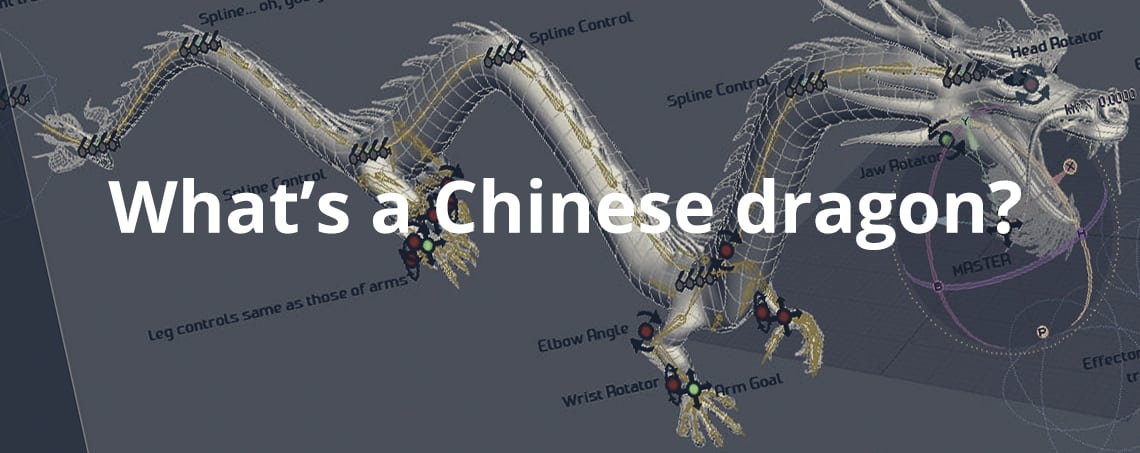
What’s a Chinese dragon?
You may have heard that Chinese people are fond of dragons, but you may wonder what a Chinese dragon looks like. Since they are quite different from the Western dragon, let’s start by giving you a description of this legendary creature.
Physical aspect
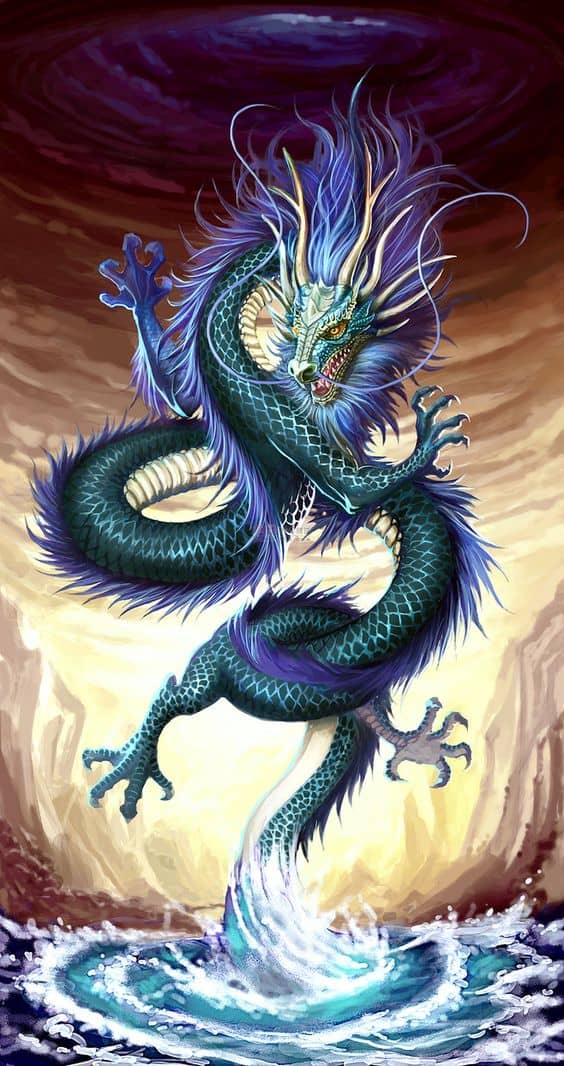
In stories, a Chinese dragon can be composed of many different animal parts. Still, it’s more commonly depicted as having: the tail of a fish, the scales of a carp, the neck of a snake, the belly of a clam, the head of a camel, the claws of an eagle, the paws of a tiger, the ears of a cow, the eyes of a demon, the beard of a goat and the horns of a stag. Quite the beast, huh?
Chinese dragons can be of many colors; they can be blue, yellow, black, white, or red. Depending on the dynasty that was ruling, the “official” Chinese dragon color varied.
Dragons under the Han and Qin Dynasty
Under the Han dynasty (206 B.C.–220 A.D.), for instance, the Chinese dragon symbolizing the Emperor, who was viewed as a god at that time, was turquoise. This turquoise Chinese dragon also symbolized the fifth element in the Chinese five elements, the sun, the East, and the West.
Han dynasty aside, it was mostly the yellow Chinese dragon chosen by the Emperors as their symbol. This was particularly the case during the Qing dynasty (from 1644 to 1912 AD). The Qing’s Emperor Yan, in fact, was said to be the offspring of his mother’s telepathic communications with a mystical Chinese dragon (not unlike the first Emperor of China, as you’ll see later), and claimed that the most powerful Chinese dragon was yellow.
Behavior
Chinese dragons are given many powers in Chinese folklore. They are said to control thunder, floods, and rain. Unlike the western dragon, rumored to be evil and dangerous, the Chinese dragon is said to be kind and noble. He symbolizes divinity, goodness, excellence, power, and energy. Dragons are also very smart. They are not to be afraid of but are mainly considered as protectors that keep people from harm. Chinese dragons typically live in heaven or worshiped places.
The Nine Chinese dragons
In addition to dragons of various colors, the Chinese believe in many different types of dragons. Some of the most well known Chinese dragons are the nine dragons.
According to a very popular legend in China, the Chinese dragon King has nine sons. These nine dragon sons all look different and hold various powers.
– 贔屭 Bì xì is the eldest dragon son. 贔屭 is usually depicted as a hybrid between a dragon and a tortoise. Its shell is so strong and large that it can carry heavy objects such as stones. You’ll often find him portrayed in old temples and on tombstones.
The second son of the Dragon King is 狴犴 Bì àn. 狴犴 looks more like a tiger than a dragon. You’ll find him keeping guard in front of jail gates, but also in courts of justice. Its main characteristic is steadiness. You can definitely trust him when it comes to security and justice!
The third dragon son is 螭吻 Chī wěn. 螭吻 looks like a big lizard because it’s a hybrid between a fish and a dragon. 螭吻 likes to swallow evil spirits to keep them away from humans. As such, people used to make 螭吻 statues and place them on their roofs ridgepole to feel protected (mostly on palaces since ordering custom-made statues was an expensive hobby). You may run into 螭吻 if you go by the sea as this dragon is said to live in the ocean.
Then, 蒲牢 Púláo is the fourth son. Nobody really knows what he looks like; some say he’s a dog combined with a dragon. His power is to scream to warn people if a disaster is coming. His loud cries are so noisy that people often represent him on bells’ handles.
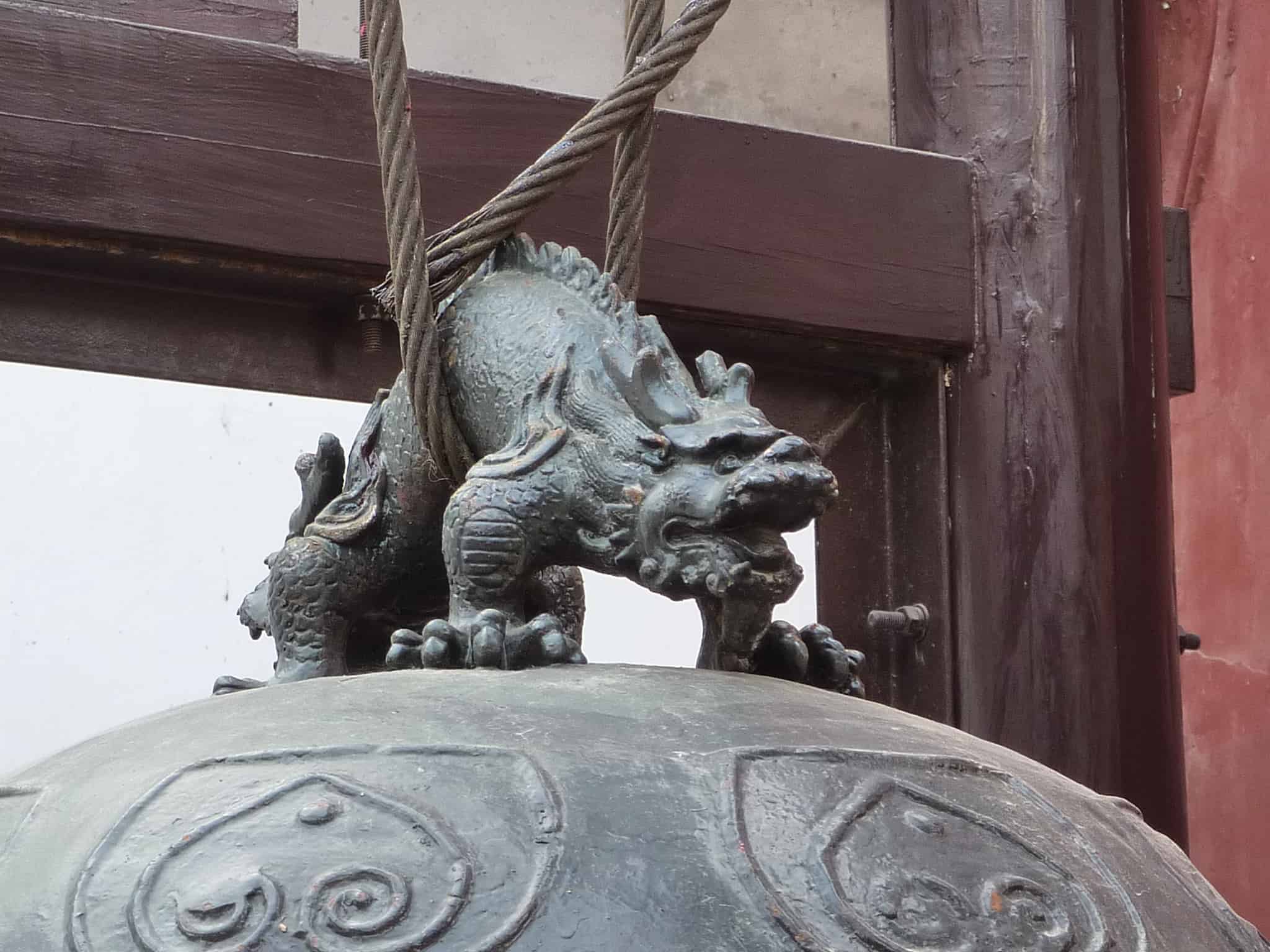
As for 囚牛 Qiú niú who is the fifth son of the Dragon King, there is no clear clue on his physical aspect. But still, according to his name 牛 niú cow, he is said to be a hybrid between a cow and a dragon. Others even claim he is a yellow dragon. One thing everyone agrees on is that 囚牛 loves music and plays it very well. So, you’ll often find him depicted on musical instruments.
The sixth son is 饕餮 Tāotiè. He is a hybrid between a wolf and a dragon and is said to be the guardian of wealth and well-being. We also found that he loves food and is very greedy and gluttonous. There’s not much information about him except that you can find him depicted on ritual bronze vessels. Nowadays, 饕餮 is used to describe people who are fond of good food.
The seventh son of the Chinese dragon King is 狻猊 Suānní. Often depicted as a hybrid between a lion and a dragon, his body is covered with flames. He is viewed as the Chinese dragon of wisdom and knowledge. 狻猊 likes to sit cross-legged and spends his days smelling incense calmly. You’ll find him in Buddhist Temples, depicted on incense burners or on the seats.
The eighth son, 睚眦 Yázì, has a leopard head and the body of a dragon. 睚眦 likes to get into fights all the time and enjoys killing. Unsurprisingly, 睚眦 is viewed as the Chinese dragon god of battles and wars. You’ll find him on sword ornaments.
And finally, 蚣蝮 Gōngfù sometimes called 霸下 Bà xià is the dragon god of the water and the Dragon King’s ninth son. He’s half-snake, half-dragon. 蚣蝮 is said to be an excellent swimmer and to live near bridges.
The 9 Dragon often used in Architecture in China
The 9 Chinese dragons are a symbol you’ll often run into in China, and it’s often used in architecture. For instance, you can check the Nine-dragon Wall in Beijing here.
So that you know, not all sources agree on which were the 9 legendary dragons. Sometimes, you’ll find others listed, and you may run into at least 14 different dragons in stories. And depending on the regions of China, different dragons can be depicted in the local folklore.
Now you know what a Chinese dragon looks like, it’s time for you to understand its origins. In ancient China, the beliefs started with the rise of the great dynasties.
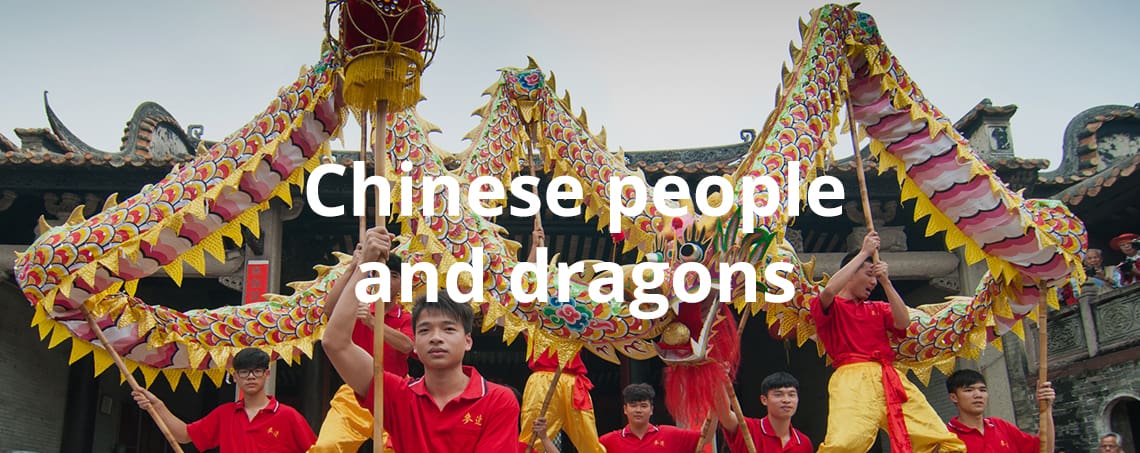
The relationship between Chinese people and Chinese dragons
Dragons have always been related to people since Chinese beliefs are firm. Let’s see how they created this magical relationship and why the dragon is such an important cultural symbol in China.
Descendants of Chinese dragons

According to legends and stories, Chinese people used to believe they descend from dragons. Say what? How is it possible? Don’t worry; we’re going to explain.
To understand why the Chinese hold this belief, you need to look at where dragon lore comes from.
Where does the Chinese dragon come from?
Stories state that a long time ago, around ~2500 BC, tribes fought each other to gain more lands in ancient China. The so-called Yellow Emperor Huang Di allied with another tribe leader named Yan Di to gain an edge in the battle. Yan Di was said to be born thanks to his mother’s telepathic communications with a powerful dragon. Ah, the story goes, that powerful dragon helped him through his quests, and thanks to the dragon’s help, both Huang Di and Yang Di defeated their common enemy the 九黎 Jiǔ lí people led by Chiyou during 涿鹿之戰 Zhuō lù zhī zhàn the Battle of Zhuolu. As Huang Di’s and Yan Di’s tribes united, they picked a dragon as the symbol for their newly-formed tribe’s banner.
Since those prehistoric times, many Chinese people have considered themselves Huang Di and Yan Di’s descendants, and therefore, the descendants of dragons. In Chinese, people say 炎黄子孙 yán huáng zǐsūn the descendants of Huang Di and Yan Di. There is also a well-known song in China that deals with 龙的传人 lóng de chuánrén the descendants of the Chinese dragon.
From Tribes to Emperors
As you see, the Chinese dragon symbol can be traced back to Ancient China. As civilization evolved and tribes gave way to dynasties in China, the dragon’s importance grew even more. Starting in the Han Dynasty, emperors started considering themselves as dragons. It all started with Liu Bang, who later on became the First Emperor of the Han Dynasty.
One day, as his mother was dreaming of meeting a divine spirit, the sky darkened, and when Liu’s father came in, he found a dragon lying next to his wife. Following this divine meeting, she became pregnant and gave birth to Liu Bang. Some people said he had a high nose, whiskers, and a strange beard that made them think of a dragon’s head. Liu Bang went on to become the first Emperor of the Han Dynasty.
The following Emperors did everything they could to keep this divine bond with dragons strong. As heirs of Liu Bang, they claimed they were Chinese dragons’ sons too, and that dragon blood was running through their veins.
The Chinese emperor Suite
From then on, everything in the Emperor’s suite was embossed with Chinese dragons: from clothes to furniture. For example, Only the Emperor was allowed to wear a dragon symbol on his clothes. Dragon claws symbolized ranks in society, and the higher-ranked, the more claws you had. Generals and leaders, therefore, could have up to 4 claws. Only the Emperor could wear a dragon with 5 claws, symbolizing the Emperor‘s actual hands. If someone else wore 5 claws and were not the Emperor, they would be killed.
As explained in Part 1, emperors also chose their Dragon’s color to show their power. The color they choose for their dragon became the most important color in society. No one else was allowed to wear that color, or they were punished.
What about nowadays?
Dragons are still a big part of Chinese culture, even if they are now more used as a mascot than a divine prodigy. The dragon has clearly become a symbol of China, recognizable all over the world.
Chinese people respect the dragon culture, and some still believe in its mystical powers. Nowadays, for instance, you’ll find dragon symbols in every Chinese celebration. The Chinese New Year is the best example to give, with parades, households, and public places are all decorated with dragons.
The Chinese dragon Dance is also very appreciated in every celebration since it wishes good luck and brings prosperity to its viewers. Here’s an example of a Chinese dragon dance, complete with a luminous dragon. It’s spectacular!
As you may know, a special festival is also dedicated to the Chinese dragon in China: the Dragon Boat Festival! You can head here to know more about this awesome festival and see how it is celebrated in China.
Zodiac signs
The Chinese dragon is also part of Chinese astrology. The dragon sign is the fifth sign in the Chinese zodiac signs. In China, people love to have a boy born during the dragon year as they say he will be lucky in life.
Persons born during dragon years are said to be ambitious, decisive, and inspiring but if you’re born under the Chinese dragon zodiac sign – just like Bruce Lee – be also careful not to be too confident and arrogant, as dragon signs are also rumored to have those character traits. Take no offense if you’re a dragon; that’s what your zodiac sign is saying, not me! 🙂
The love for dragons anyway
Chinese dragon’s origins are unclear — the dragon being a mythological creature and all — and we have to rely on stories and legends to understand how dragons appeared in Chinese folklore. But those stories definitely help us see how the dragon became an essential symbol in Chinese society and why Chinese people are still really close to the dragon symbol. Who can blame them? Dragons are fascinating, don’t you think?
If you were thinking of getting a Chinese dragon tattoo, we have an even better suggestion for you: become a dragon yourself! How? By joining Ninchanese, a Chinese learning application where you get to level up your dragon as you learn Chinese. And for those who are already learning Chinese on Ninchanese, you’re ready to beat every single boss in Ninchanese by using the Chinese dragon’s powers! You’ll improve so much now you know everything about Lupishu’s origins 🙂
Did you know any of these facts? What surprised you the most? Let us know what you thought about it!
For more dragon pictures, head to Ninchanese Pinterest Collection; you can also add your favorite ones.
Pauline and
The Nincha Team
Stay in touch with us on Facebook, Twitter, Instagram, and Pinterest.

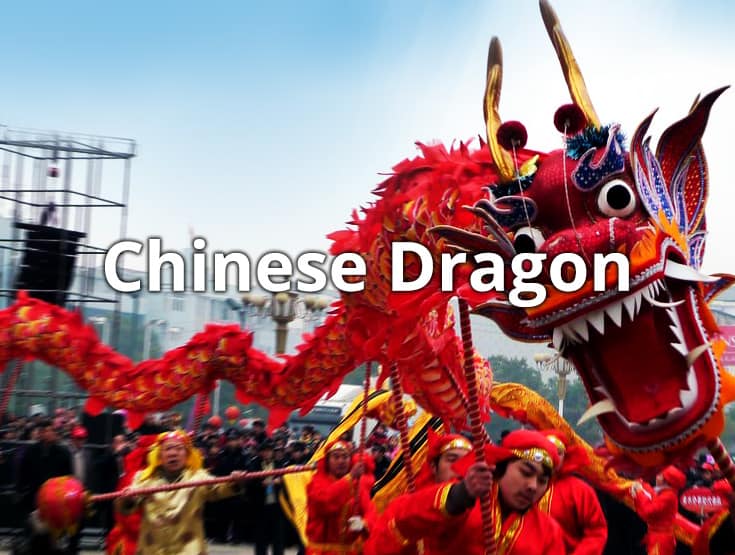
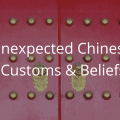
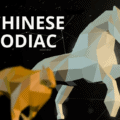


6 comments
Join the conversationPingback: Mandarin Weekly #64 – Mandarin Weekly (每周中文)
Pingback: All You Need to Know About The Chinese Dynasties - Ninchanese
Pingback: The 12 Chinese Zodiac Signs And The Leftover Cat - Ninchanese
Pingback: How to Make Your Chinese Lantern - Ninchanese
CJ - April 3, 2018
Chinese dragons are pure imaginations from meteors just as is the heavenly dog swallows the sun during an eclipse. See the similarly of the glowing/burning orb at the mouth of the dragon with a long body and the burning meteor with a trail of smoke.
Pingback: Simplified Chinese characters VS Traditional Chinese characters - Ninchanese
Comments are closed.